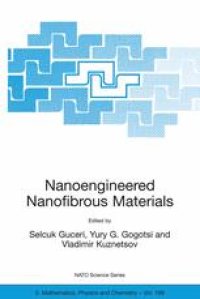
Ebook: Nanoengineered Nanofibrous Materials
- Tags: Automotive and Aerospace Engineering Traffic, Mechanics, Characterization and Evaluation of Materials
- Series: NATO Science Series 169
- Year: 2004
- Publisher: Springer Netherlands
- Edition: 1
- Language: English
- pdf
The combination of conductive polymer technology with the ability to produce nanofibres will facilitate major new developments in biotechnology and information technology, benefiting such areas as scaffolds for tissue engineering and drug delivery systems; wires, capacitors, transistors and diodes; sensor technology; biohazard protection; and energy transport, conversion and storage.
The work on nanofibrous materials presented here is designed, first of all, to instruct scientists in the most advanced methods for the formation of nanofibres and nanotubes. The second section covers the physics and chemistry of nanofibres, while the third deals with computer simulation and modelling. The applications described in section 4 include biomedical applications, nanotube-based devices, electronic applications of nanotubes and nanofibres, nanofluidics, and composites. Finally, the fifth section discusses recent developments in nanomaterials, nanoparticles and nanostructures.
The combination of conductive polymer technology with the ability to produce nanofibres will facilitate major new developments in biotechnology and information technology, benefiting such areas as scaffolds for tissue engineering and drug delivery systems; wires, capacitors, transistors and diodes; sensor technology; biohazard protection; and energy transport, conversion and storage.
The work on nanofibrous materials presented here is designed, first of all, to instruct scientists in the most advanced methods for the formation of nanofibres and nanotubes. The second section covers the physics and chemistry of nanofibres, while the third deals with computer simulation and modelling. The applications described in section 4 include biomedical applications, nanotube-based devices, electronic applications of nanotubes and nanofibres, nanofluidics, and composites. Finally, the fifth section discusses recent developments in nanomaterials, nanoparticles and nanostructures.
The combination of conductive polymer technology with the ability to produce nanofibres will facilitate major new developments in biotechnology and information technology, benefiting such areas as scaffolds for tissue engineering and drug delivery systems; wires, capacitors, transistors and diodes; sensor technology; biohazard protection; and energy transport, conversion and storage.
The work on nanofibrous materials presented here is designed, first of all, to instruct scientists in the most advanced methods for the formation of nanofibres and nanotubes. The second section covers the physics and chemistry of nanofibres, while the third deals with computer simulation and modelling. The applications described in section 4 include biomedical applications, nanotube-based devices, electronic applications of nanotubes and nanofibres, nanofluidics, and composites. Finally, the fifth section discusses recent developments in nanomaterials, nanoparticles and nanostructures.
Content:
Front Matter....Pages i-xii
Formation of Nanofibers and Nanotubes Production....Pages 1-129
Physics and Chemistry of Nanofibers....Pages 131-182
Simulation and Modeling....Pages 183-244
Applications....Pages 245-468
Nanomaterials, Nanoparticles, and Nanostructures....Pages 469-540
Back Matter....Pages 541-543